Michael Jordan: Applied Bayesian Nonparametrics
Labels: bayesian, jordan, nonparametric
Public News and Announcements Blog from the School of Informatics at the University of Edinburgh.
Labels: bayesian, jordan, nonparametric

|

|

|
|

|
 Today we had a snowball fight. See picasa for more images of the roof garden in the snow.
Today we had a snowball fight. See picasa for more images of the roof garden in the snow.Labels: edinburgh, forum, informatics, snow, winter
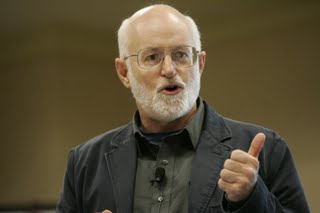
This talk will illustrate a fundamental feature of informatics that explains its relevance to every academic discipline, namely the role of computing and digital information technologies and ideas in accelerating discoveries and creating knowledge totally inaccessible without them.
The impact of informatics on the academy will be large, changing how we create, preserve and disseminate knowledge - that's the core university mission. This centrality to the university's mission increases demand for education in this field that serves the needs of all students. It requires us to teach broad computational thinking and create a basis for life-long learning in this rapidly changing field.
This lecture is supported by SICSA and IDEA lab Edinburgh.
Labels: computational, constable, idea, informatics, sicsa, thinking
Labels: Honorary, Professor, Wayne Davies
on behalf of the British government, and all those who live freely thanks to Alan's work I am very proud to say: we're sorry, you deserved so much better.That's how to say it (ignoring the punctuation error — the missing comma after work): not a bunch of evasive mumbling about how unfortunate it all was, but a simple "We're sorry."
Labels: Honorary Professor
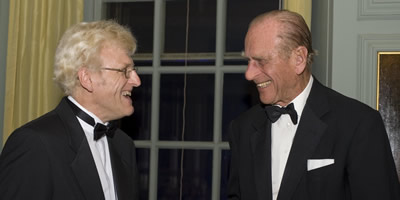
HRH The Prince Philip Duke of Edinburgh presented the Chancellor's Award for Teaching to John Lee at a gala dinner in the Palace of Holyroodhouse.
John Lee has led development of a system known as "YouTute", supported by a grant from the Principal's e-Learning Fund (2007-8). In this system, video recordings of tutorial discussions are made available to students. The recordings of entire tutorials (from two cameras and a Smartboard) are streamed in an online environment in which students can extract "virtual clips" from the videos, annotate, tag and comment these, share them, and keep them for future reference. The videos are presented accompanied by the tutorial question sheets and, where appropriate, solutions, as well as the relevant lecture slides. This creates a new kind of learning resource, around which the students can develop a collaborative learning activity that will promote reflection, deepen understanding, and add significantly to the value of the original tutorial experience. Students can also observe different approaches to particular problems (and to teaching and learning) as revealed in different tutorial groups' discussions.
A robust prototype system is currently being trialled in Informatics, with great potential also for use in many other areas of the University. Over 50 tutorials were recorded in AY 2007-8 from Informatics 2A/B,which have been made available to all second year Informatics students since then (nearly 400 students). The system was especially appreciated by resit students revising during the summer, who used the system for over 50 hours, suggesting that it may be very helpful for the slower learners.
Collection of tutorials continues. The next step is to integrate recordings of lectures, which are increasingly captured in many subject areas, allowing these also to be re-used in a much more flexible and substantial way. The system is also the focus of research to assist students further by developing automated means of indexing and tagging the videos, exploiting methods developed in existing Informatics research on multi-party meetings.
YouTute exploits vicarious learning, which is learning from exposure to the learning experiences of others. John Lee has a long history of working to develop innovative ways of exploiting the concept of vicarious learning. He has been investigating this idea, with collaborators, in a series of projects since 1995, funded by EPSRC, ESRC, and the Teaching and Learning Research Programme — the recent Principal's e-Learning Fund grant has enabled a sharper focus on application to be added to this work. There is clear evidence that vicarious learning has substantial benefits for motivation and attitude as well as discussion skills and learning strategies. Research elsewhere also suggests that vicarious learners learn better if they collaborate with each other. It is to exploit these benefits, and also to evaluate subject-specific learning in much more detail, that practical application has become the focus, leading to the current YouTute deployment.
John has been keen to promote innovations in teaching for many years. 10 years ago, in what is now the School of Arts, Culture and Environment, he co-developed the highly successful MSc in Design and Digital Media. He introduced teaching of web design and technologies at a very early stage, and continues to teach these and direct this programme. In his seconded position in Informatics, he was the founding course organiser of the pioneering Informatics Entrepreneurship courses, one of which has also been adapted for use in Design and Digital Media.
Labels: award, chancellor, congratulations, learning, lee, vicarious, youtute

I am delighted to announce the appointment of Vijayanand Nagarajan to a lectureship in Informatics, funded by the Numerical Algorithms and Intelligent Software Centre.
Vijay 's research interests lie in the areas of compilers, computer architecture and software engineering. He plans to work within ICSA on problems that span these areas. He plays cricket, violin and electric guitar.
Vijay received his MS degree in Computer Science from the University of Arizona in 2005. He spent the summer of 2006 as a research intern at the Intel Programming Systems Laboratory, and has studied for his PhD under the direction of Prof. Rajiv Gupta, in the Department of Computer Science and Engineering at the University of California, Riverside. His dissertation proposes an efficient and programmable runtime monitoring approach for multicores, which can be used to increase the performance and reliability of parallel programs running on such architectures.
Vijay expects to defend his PhD in August 2009, and will then join the school in October.
Labels: appointment, informatics, lectureship, NAIS, Vijay Nagarajan
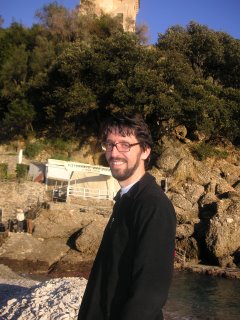
I am delighted to announce that Dr Guido Sanguinetti will join the School of Informatics on 1st August, as a SICSA lecturer.
Guido received his MSc (Laurea) in Physics in his native Genova, and then pursued a D.Phil. in Mathematics at the University of Oxford, working on algebraic and differential geometric methods to solve nonlinear differential equations.
After two years as a professional musician, he returned to research in 2004 as a postdoc and then a lecturer in Computer Science in Sheffield. His main research interests lie in reverse engineering dynamical systems governed by sets of (stochastic) differential equations, with a particular focus on applications in systems biology.
Guido will take a leave of absence to allow him to complete some projects at Sheffield, but he plans to make several extended visits to Edinburgh before moving to Scotland in 2010.
Labels: appointment, edinburgh, informatics, sanguinetti, sheffield, sicsa
Congratulations to "Phil Wadler on his election as Chair of SIGPLAN 2009-2012
Phil says, "Programming languages stand poised to take centre stage, as the web and multicores push distributed and concurrent computing to the forefront."
Rod has made deep, seminal contributions to the design of programming languages and the field of program verification. These contributions, which many of us now take for granted, include the introduction of algebraic datatypes coupled with pattern-matching clausal function definitions as found in Hope, ML, Haskell and Coq; the generalization and use of structural induction for proving properties of programs; the fold-unfold method for deriving efficient, provably-correct programs from easy to understand prototypes; mechanisms for reasoning about pointer-based, imperative programs that directly led to the development of separation logic; proof techniques and connections to modal logic for reasoning about concurrent programs; and the use of dependent types and algebraic specifications for constructing module systems that directly influenced SML and OCaml. Through these amazing contributions and his collaborations and mentorship, he helped build one of the most important centers of programming research at Edinburgh, which was eventually institutionalized as the Laboratory for Foundations of Computer Science.
Labels: achievement, award, Burstall
Amin's paper, A better algorithm for random k-SAT will receive the Best Paper Award of ICALP 2009, Track A.
The award will be conferred at the EATCS General Assembly on Tuesday, July 7
Labels: best paper, Coja-Oghlan, ICALP

I am delighted to announce the appointment of Dr. Charles Sutton to a SICSA lecturership in the School of Informatics.
Charles has been a postdoctoral researcher at the University of California, Berkeley, since 2007. His recent work has aimed at new statistical machine learning methods designed to aid the management of large-scale computer systems. In particular, he has developed methods for performance modeling that are rooted in machine learning, applying them to the control, visualization, and diagnosis of distributed Web applications. More generally, his research interests include machine learning, graphical models, approximate inference, structured prediction, natural language processing, and the application of machine learning methods to computer systems. Charles received his PhD from the University of Massachusetts Amherst in 2008. His thesis work concerned efficient training methods for conditional random fields, with applications in natural language processing.
Labels: appointment, berkeley, charles sutton, edinburgh, informatics, machine learning

I am delighted to announce that Dr Iain Murray will join the School of Informatics on 1st August, as a SICSA lecturer and a member of the Institute of Adaptive and Neural Computation.
Iain received MA and MSci degrees in Natural Sciences (Physics) from the University of Cambridge before obtaining a PhD from the Gatsby Computational Neuroscience Unit at University College London. His thesis introduced a range of new 'Markov chain Monte Carlo' algorithms for solving integrals in hard statistical inference problems. While at Gatsby Iain also developed strong interests in probabilistic modelling and efficient algorithms for solving inference problems.
Partly supported by a Canadian Commonwealth Research Fellowship, Iain moved to Toronto in 2007 and joined the Machine Learning group there as a postdoctoral fellow. He has continued to expand the applicability of Markov chain Monte Carlo methods for statistical applications, such as the evaluation of large-scale probabilistic models. Iain has also formed collaborations to apply and extend hierarchical Bayesian methods. Recent application areas include understanding human perception and inferring celestial dynamics.
Iain will take a leave of absence to allow him to complete his Fellowship in Toronto, but he plans to make several extended visits to Edinburgh before moving to Scotland in 2010.
Labels: appointment, edinburgh, gatsby, iain murray, informatics, monte carlo
Congratulations to Peter Buneman on his election as a Fellow of the Royal Society.
A total of eleven past and present distinguished Edinburgh informaticians have been elected to this fellowship. Of these, Peter Buneman, Robin Milner and Gordon Plotkin are current members of the School.
Peter Buneman is distinguished for his advances in uniting programming languages and databases. On the theoretical side this has involved new results in types, monads and structural recursion including (with his student Ohori) type inference for record types, and (with Tannen et al) results that demonstrated a tight connection between monad-based languages and those based on the predicate calculus. On the application side, he used these techniques to demonstrate that -- contrary to an assertion by the US Department of Energy -- queries on existing non-relational genomic databases could be directly evaluated; fruitful collaboration with biologists ensued.
This research on databases and languages carries over into his recent study of the principles of semistructured or "web-like" data of which he is a leading proponent, and co-author of the first text book in this new field. Another recent concern is with the provenance of data on the Web, where data is continually copied and transformed. Already, with Khanna et al. he has built an efficient archiving system for scientific databases; more fundamentally, he seeks a formal basis for tracing provenance.
In addition to his work in databases, Buneman's early work on mathematical phylogeny underlies most modern phylogenetic reconstruction techniques.
Labels: buneman, edinburgh, FRS, informatics
I am delighted to announce that Robin Milner is returning to the University of Edinburgh, part-time. He will be a SICSA Advanced Research Fellow and will hold the Chair of Computer Science.
Robin Milner graduated from Cambridge in 1958. After short posts he joined the University of Edinburgh in 1973, where he co-founded the Laboratory for Foundation of Computer Science in 1986. He was elected Fellow of the Royal Society in 1988, and in 1991 won the ACM's A.M. Turing Award. He joined Cambridge University in 1995, headed the Computer Laboratory there for four years, and retired in 2001. His research achievements (often joint) include: the system LCF, a model for many later systems for interactive reasoning; Standard ML, an industry-scale but rigorously based programming language; the Calculus of Communicating Systems (CCS); the Pi Calculus.
Currently he works on Bigraphs, a topographical model which aims to provide a theoretical foundation for mobile interactive systems. Cambridge University Press has just published The Space and Motion of Communicating Agents, Robin's book on this area.
Robin will be giving a short course on bigraphs in Edinburgh on May 13th and 14th 2009. So that we can keep track of numbers, please sign up for the course at http://milner-bigraphs.eventbrite.com (password is milner).
Labels: appointment, bigraphs, computation, edinburgh, forum, informatics, milner, mobility, model, sicsa, ubiquitous
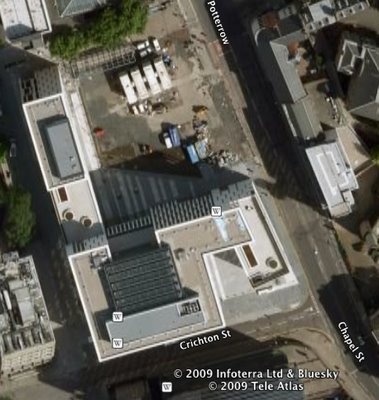
Google has updated Google Earth with new images for Edinburgh Southside, dated 21 July 2008.
Open the title link with Google Earth to see the George Square masterplan superimposed on the Forum.
Labels: earth, edinburgh, forum, google, informatics, potterrow, university
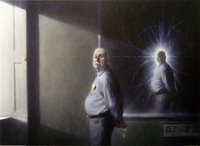
Peter Higgs was the first student of Christopher Longuet-Higgins, one of the forefathers of Informatics at Edinburgh.
The School is delighted to host Peter's recent portrait by Ken Currie. The portrait will hang in the Forum for the next few months, until it moves to its permanent home in the James Clerk Maxwell Building.
Mark Steedman and David Willshaw were also students of Longuet-Higgins.
Labels: art, forum, Ken Currie, peter higgs, portrait
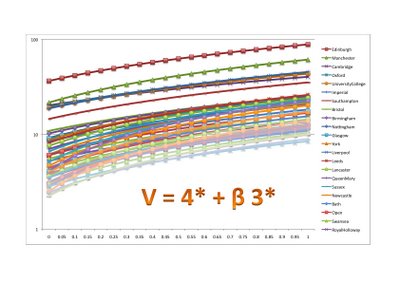
HEFCE has published preliminary results of the RAE.
These comprise tabulated overall quality profiles per unit of assessment (UoA) and per institution. Each quality profile presents the proportions, rounded to 5 per cent, of research activity in each submission judged to have met each of the quality levels from 4* to unclassified. Alongside the quality profile for each submission, HEFCE publish the full-time equivalent (FTE) number of Category A staff included in the submission.
The highest, 4* grade is awarded for work that is world-leading; 3* is for internationally excellent, and 2* for internationally recognised research.
Taking the profile percentages of the FTE staff number gives a research volume profile for each submission.
These results confirm that the University of Edinburgh is, once again, the strongest in the UK for research in Informatics and Computer Science.
Informatics at Edinburgh delivers more world-leading (4*) research than anyone else — 69% more than our nearest competitor.
We contribute 10% of the UK's world-leading research in this UoA.
We deliver more internationally-excellent (3*) or world-leading (4*) research than anyone else — 44% more than our nearest competitor. Edinburgh contributes more research that is at least internationally excellent than Oxbridge.
Overall, ours is the largest research grouping in the UK — again, 44% larger than our nearest competitor.
All of our research is internationally recognised, or better (2*, 3* or 4*) — and we submitted every eligible member of staff.
The use of grade profiles means that there is no single ranking as a result of this RAE.
The detailed formulae for research funding based on the RAE will not be announced by funding councils for several months. However, future research funding is expected to be based on a weighted sum over the RAE volume profile.
For any score given as a weighted sum S = α 4* + β 3* + γ 2* + δ 1*, where &alpha > 0 and α ≥ β ≥ γ ≥ δ ≥ 0, Edinburgh scores top in the UK.

Our volume of world-leading and internationally excellent research (88.6 FTE) exceeds our entire submission to RAE 2001 (80.2 FTE). In addition, we have recently made half a dozen outstanding new appointments, not included in this assessment, that further increase our research excellence and capacity. We have also recently improved our environment by moving into the Informatics Forum — acclaimed as the best building in Scotland. This building, designed for interaction, brings an eclectic multidisciplinary collection of over 500 researchers in Informatics and Computer Science together, under one roof.
Edinburgh has the UK's strongest research group in Linguistics, with more world-class (4*) research in Linguistics (10.8 FTE) than any two other submissions combined. Through the Human Communication Research Centre (HCRC) and the Centre for Speech Technology Research (CSTR), we work closely with these colleagues in the areas of Speech and Language Processing, Computational Linguistics and Cognitive Science.
The Scottish Informatics and Computer Science Alliance (SICSA) brings together internationally excellent research from across Scotland, to double the University of Edinburgh's 3* + 4* volume. This critical mass of excellence makes Scotland a match for any leading centre of Informatics and Computer Science, worldwide.
SICSA is actively recruiting, and plans to complete appointments to some 30 new posts by the end of 2010. Our policy is to recruit internationally, to make outstanding appointments that raise our research quality, and further strengthen Scotland's profile in Informatics and Computer Science.
Eighty-one submissions were made to UoA 23. The top ten (by 4* volume) account for over 50% of the UK's world-leading research in this UoA.
Manchester is our nearest competitor. Cambridge, Oxford, University College, and Imperial College — almost indistinguishable from one another — come next, followed by Southampton; Bristol, Birmingham and Nottingham complete the top ten.
The abscissa is a parameter β
The ordinate (plotted on log scale) is V = 4* + β 3*
The point is that whatever reasonable combination of 4* and 3* volume you choose to take, Edinburgh comes out tops.
The use of a log scale makes it easier to compare relative sizes. For example, the gap between Cambridge and Manchester at the right-hand end of the graph signifies that Manchester has roughly 50% more 3* + 4* volume than Cambridge. A slightly larger gap at the left-hand end between Manchester and Edinburgh signifies that Edinburgh has more than 50% more 4* volume than Manchester.
Labels: 2008, computer science, computing, edinburgh, informatics, linguistics, RAE, Scotland, sicsa, uk